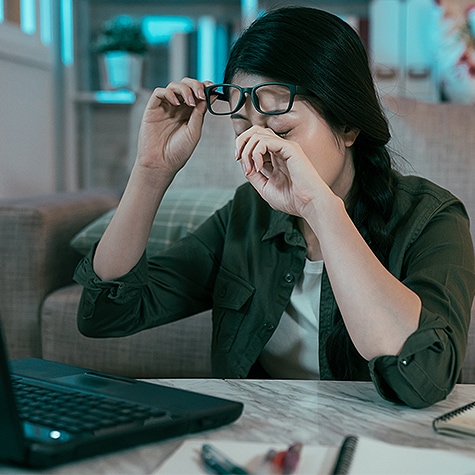Monitoring Your Screen Time
Digital screens have become a staple in everyday life and, for most people, unavoidable. Whether you’re spending time staring at a digital screen for work or entertainment, long hours can sometimes seem inevitable, and our eyes can pay the price.
At Experts on Sight, we help our patients manage the effects of digital eye strain and discuss different prevention methods to implement in their daily lives.
Contact us to book an appointment and manage your digital eye strain symptoms today.


Understanding Digital Eye Strain
Digital eye strain, also known as computer vision syndrome, is a visual condition that can affect your eyes following long hours in front of a computer, tablet, phone, or other digital screens.
The effects of digital eye strain can be magnified by preexisting conditions such as myopia, astigmatism, and presbyopia.
Common signs and symptoms of digital eye strain may include:
- Blurred vision
- Headaches
- Neck and shoulder pain
- Dry eyes
Symptoms can worsen over time and cause other vision issues if not addressed. Digital eye strain is all about management and addressing your discomfort as soon as possible.

Practicing Prevention at Home
Digital eye strain can be challenging to manage. The first step is visiting us for a comprehensive eye exam so we can get to the bottom of your symptoms. The severity of your symptoms can depend on various factors such as your posture, lighting, glare, and angle of your workstation monitor.
Our team can review your digital device habits and discuss various management methods to help you find relief.
The 20-20-20 Method
While we’re all familiar with an intense work session on the computer, taking a break is crucial. The 20-20-20 rule is designed to give your eyes some well-deserved rest.
The 20-20-20 method involves:
- Looking away from your screen every 20 minutes
- Focusing on something 20 feet away
- Looking at the object of focus for at least 20 seconds
Taking frequent breaks throughout the day is recommended to give your eyes sufficient time to rest.
Adjust the Positioning of Your Screen
Screen positioning can play a crucial role in proper posture, lighting, and limiting glare. Your screen should be about arm’s length away from your eyes, and you should keep your screen at eye level or slightly below.
An anti-glare screen is also an excellent investment to help reduce glare from surrounding lights. If you need to enlarge the text on your screen to avoid squinting, please do so.
Find Comfortable Lighting
Your lighting at your workstation can play a part in causing eye strain. Depending on your specific activity, lighting can be too dim or too bright.
Finding a good balance of light is essential, and adjusting your screen brightness, so you’re not squinting or straining your eyes is crucial.
Finding a Balance
Advancements in work and entertainment technology have made digital screens a natural part of daily living. Finding a good balance is crucial to prevent digital eye strain from settling in.
Contact us to book an appointment to better understand and find relief from your digital eye strain symptoms.
Our Locations

Gilbert
We’re located just off Lindsay Road in the San Tan Professional Village, with plenty of parking out front. If you have trouble finding us, please give us a call.
- 480-292-9835
- 480-292-9836
- [email protected]
- 3303 South Lindsay Road, Suite 101
- Gilbert, AZ 85297
Hours of Operation
- Monday: 9:00 AM – 5:00 PM
- Tuesday: 9:00 AM – 6:00 PM
- Wednesday: 9:00 AM – 6:00 PM
- Thursday: 8:00 AM – 3:30 PM
- Friday: 9:00 AM – 5:00 PM
- Saturday: Closed
- Sunday: Closed
Mesa
Find us right off East McKellips Road in the same parking lot as Arby’s. Feel free to contact us if you have any trouble finding our location.
- 480-844-2286
- 480-610-6641
- [email protected]
- 1919 East McKellips Road, Suite 103
- Mesa, AZ 85203
Hours of Operation
- Monday: 9:00 AM – 5:00 PM
- Tuesday: *Closed
- Wednesday: 9:00 AM – 6:00 PM
- Thursday: 9:00 AM – 5:00 PM
- Friday: 9:00 AM – 5:00 PM
- Saturday: Closed
- Sunday: Closed



About Us
Eye Exams
Specialty Eye Care
Experts on Sight – Gilbert
- 3303 South Lindsay Road, Suite 101
- Gilbert, AZ 85297
- 480-292-9835
- 480-292-9836
- [email protected]
Abbot Eye Care – a Division of Experts on Sight
- 1919 East McKellips Road, Suite 103
- Mesa, AZ 85203
- 480-844-2286
- 480-610-6641
- [email protected]








